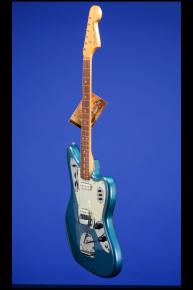A Fabulous Lake Placid Blue Jaguar!
This 13 3/4-inch-wide Jaguar weighs 7.90 lbs. and has a "B" nut width of just under 1 5/8 inches and a scale length of 24 inches. Solid alder body, one-piece maple neck with a nice medium profile and a curved veneer rosewood fretboard with 22 original frets and inlaid pearloid dot position markers. Headstock with matching "Lake Placid Blue" finish and decal with "Fender" logo in gold with black trim, "Jaguar" in black beside it, and four design and patent numbers in black below. "Offset Contour Body" decal at the ball end of the headstock. Single "butterfly" string tree with nylon spacer. The neck is stamped "1 FEB 65B." Four-bolt neck plate with serial number "L85436" between the top two screws. Individual double-line Kluson Deluxe tuners with oval metal buttons, each one stamped on the underside "D-169400 / Patent No." Two white oblong Strat-like pickups with notched metal side plates and outputs of 6.12k and 6.04k. Three-layer mint-green over black & white plastic pickguard with ten screws. Two controls (one volume, one tone) and jack socket on lower metal plate adjoining pickguard on the treble side, circuit selector (rhythm/lead) slide switch and two roller controls (one volume, one tone) on upper metal plate adjoining pickguard on the bass side, and three pickup selector slide switches on metal plate inset into the pickguard on the treble side. The potentiometers are stamped "137 6519" and "304 6515" (CTS May 1965 and Stackpole April 1965). Black plastic Jaguar knobs with white markings. Jazzmaster-type floating tremolo and bridge with adjustable mute. Complete with the original tremolo arm, chrome bridge cover and original Fender Jaguar instruction manual, hang tag with matching serial number. This guitar is in near mint (9.25) condition, with just some very light finish checking and a few very small and insignificant surface marks on the sides. A fabulous example with the Lake Placid Blue finish completely unfaded, bright and fresh. The neck shows virtually no fretboard wear and just some very minor fret wear on the first five frets. There is a tiny cigarette burn (the size of a matchhead) on the face of the headstock just above the low E tuner ferrule. Housed in the original Fender black hardshell case with black leather ends, and dark orange plush lining (9.25).
Fender introduced the Lake Placid Blue finish in 1960. "Du Pont was the biggest supplier of paint to the car factories, most notably those of General Motors. Fender used paints from Du Pont's Duco nitro-cellulose lines, such as Fiesta Red or Foam Green, as well as the more color-retentive Lucite acrylics like Lake Placid Blue Metallic or Burgundy Mist Metallic. As Custom Color researcher Clay Harrell has established, these names given to the colors came from the original car makers' terms: Fiesta Red, for example, was first used by Ford in 1956 for a Thunderbird color, while Lake Placid Blue originally appeared on a 1958 Cadillac Brougham." (Tony Bacon and Paul Day, The Fender Book, p. 30).
"Not content with the relatively expensive Jazzmaster, Fender introduced a new top-of-the-line model in 1962: the Jaguar. [The pricelist offered a basic Sunburst Jaguar at $379.50; a similar Jazzmaster was $349.50]. Another offset-waist multi-control instrument, the Jag seemed an attractive proposition, but still failed to dent the supremacy of Fender's dynamic duo, the Tele and the Strat...The Jag used a similar offset-waist body shape to the earlier Jazzmaster, and also shared that guitar's separate bridge and vibrato unit, although the Jaguar had the addition of a spring-loaded string mute at the bridge. Fender rather optimistically believed that players would prefer a mechanical string mute to the natural edge-of-the-hand method. They did not. There were some notable differences between the Jaguar and Jazzmaster. Visually, the Jag had distinctive chromed control panels, and was the first Fender with 22 frets. Its 24" (610mm) scale-length ('faster, more comfortable') was shorter than the Fender standard of 25" (635mm) and closer to that of Gibson. It gave the Jag a different playing feel compared to other Fenders. The Jaguar had better pickups than the Jazzmaster. They looked much like Strat units but had metal shielding added at the base and sides, no doubt as a response to the criticisms of the Jazzmaster's tendency to noisiness. The Jag's electrics were yet more complex than the Jazzmaster's, using the same rhythm circuit but adding a trio of lead-circuit switches...The Jaguar was offered from the start in four different neck widths, one a size narrower and two wider than normal (coded A, B, C or D, from narrowest to widest, with 'normal' B the most common)" (Tony Bacon, 50 Years of Fender, p. 36).













